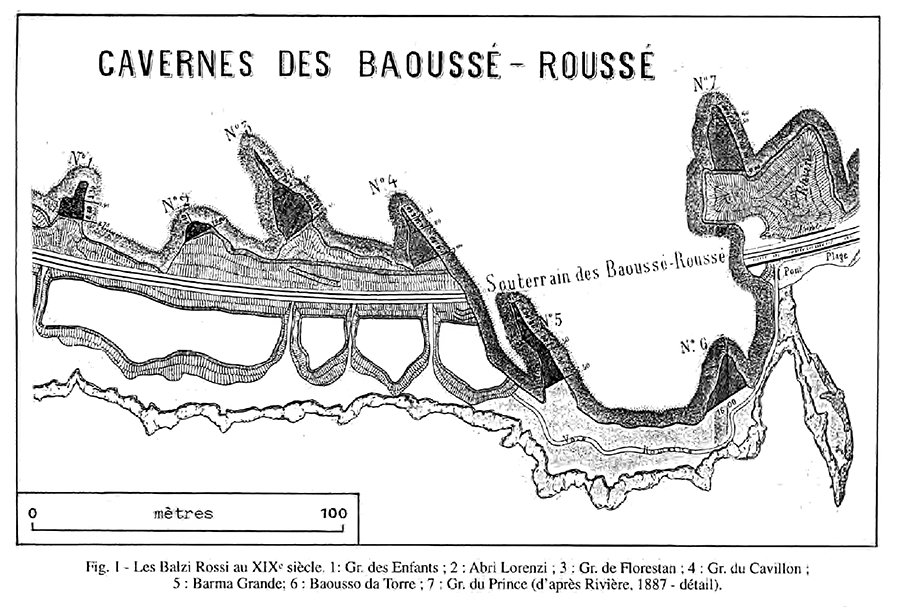Back to Don's Maps
Back to Venus figures from the Stone Age
Figurines of Balzi Rossi, the Grimaldi Caves venuses
On the Liguria coast to the French border are the entrances of the complex of the caverns of the Balzi Rossi (literally red leaps). The name of the locality derives from the color of the limestone walls that, because of the iron mineral presence oxidises to a red colour. The complex is composed of numerous coves and shelters, including Grotta dei Fanciulli, Riparo Lorenzi, Grotta di Florestano, Grotta del Caviglione, Barma Grande, Barma del Bauso da Ture (now destroyed), Grotta del Principe, Grotta Gerbai, Grotta Costantini, Riparo Mochi, Riparo Bombrini, cavernette della cava, Grotta Voronov, and Grotta Grimaldi. The first searches occurred in 1846-57, by the prince of Monaco, Florestano I. More recently, between 1928 and 1959, regular diggings were executed by A.C. Blanc, L. Cardini and To Mochi, on behalf of the Italian Institute of Human Palaeontology. Louis Alexandre Jullien discovered, between 1883 and 1895, about fifteen figurines, the greatest series ever found in only one place in Western Europe.
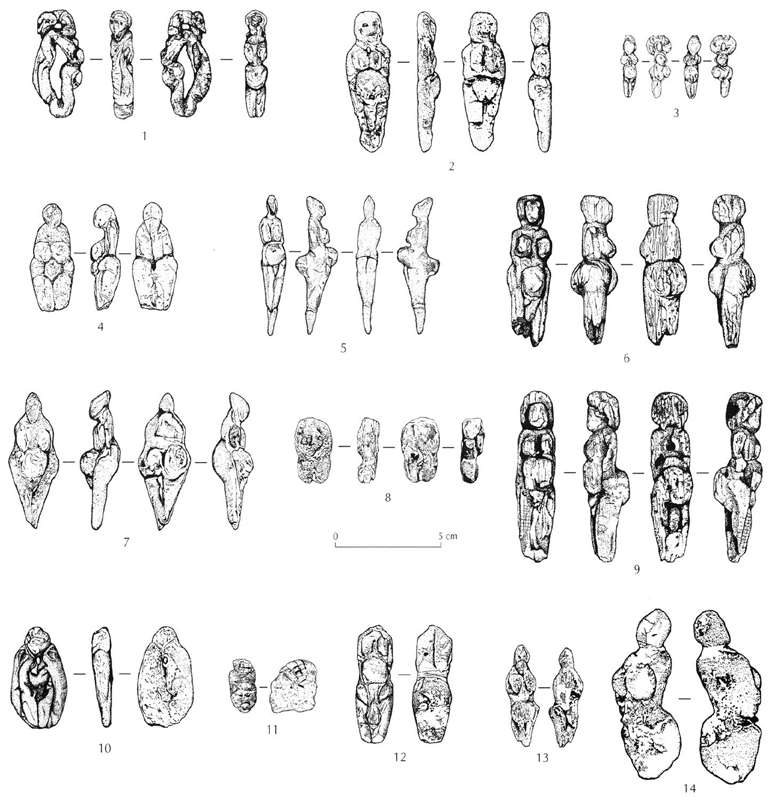
Grimaldi figurines.
The fourteen Grimaldi statuettes described by White et Bisson (1998):
1. The Couple, or the Double Venus
2. Woman with the perforated neck
3. The Two-Headed Woman
4. The yellow steatite statuette, or the Venus of Menton
5. Pulcinella or the Venus of Polichinelle
6. Brown Ivory Figurine
7. The Venus el Rombo, or Venus de Losange, (the diamond, or rhomboid, or lozenge shaped venus)
8. The Bust
9. The ivory figurine in red ochre
10. The flattened figure
11 The Negroid head
12. The Hermaphrodite
13. The Woman with goitre
14. Undescribed figure
Photo: White et Bisson (1998)
The fifteen statuettes were discovered in the sites of Barma Grande, la grotte du Prince, and perhaps le Jardin Abbo, excavated between 1883 and 1895 by Louis Jullien. At present, seven of them are in the vaults of the Musée des Antiquités Nationales (MAN) at Saint-Germain-en-Laye, one (the Woman with the Perforated Neck, also known as the 'Janus' figurine because of the two faces) is in the Peabody Museum of Harvard and the last seven were found in Montreal where Jullien emigrated in about 1898.
The seven Canadian specimens recently surfaced in an antique store in Montreal (Bisson, Bolduc, 1994).They include five representations of women, a possible but uncertain female figure, and a face of indeterminate species and gender. Accompanying documents and interviews with their owners showing that these objects belonged to the collection of Louis Jullien, which had been lost track of in Montreal at the beginning of the 20th Century.
The pieces found are generally in good condition and form a substantial sample of the known Gravettian-Epigravettian female sculptures of Western Europe.
Text above: White et Bisson (1998)
In private hands
Louis Jullien immigrated to Canada between 1895 and 1900. He had earlier married a Quebec woman and had five children. Although he continued to sell materials that he had brought from the Grimaldi caves, his primary work was as a chemist. In Montreal he lived with his son, Louis Joseph, and a daughter, Louise. Both he and his son corresponded with Piette and Dupaigne about the statuettes. During World War I Dupaigne and Breuil lost contact with the family. In 1926 Louis Joseph was killed in a train accident, and shortly thereafter, in 1928, Louis died at age 84.Most of the specimens were inherited by Louise Jullien. Another daughter, Laurence Jullien Stern, obtained one which she took with her on moving to New York City, and this specimen, the "Femme au cou perfore," was sold to Harvard in 1944 (Marshack 1986). When Louise Jullien died, the remaining figurines passed to the youngest daughter, Blanche Jullien. Through Blanche the material was obtained by other family members,'' who gave part of the collection to the antique-shop owner in 1990. When they were purchased, most of the specimens were still wrapped in badly deteriorated tissue paper and had obviously not been unpacked for decades.
Text: Bisson and Bolduc (1994)
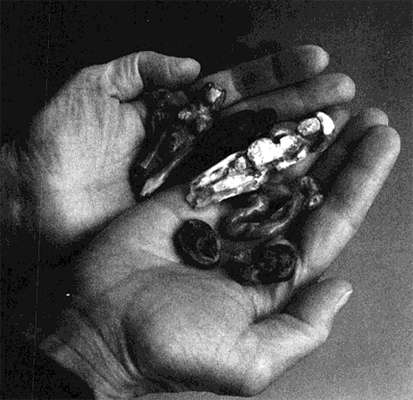
The rediscovered ivory and soft stone figurines.
Photo: J. Cinq-Mars, © Pierre Bolduc, Montreal
Presently held: In private hands, joint property of Pierre Bolduc who found them in a Montreal antique shop, and the descendants (Laurence and Lucie) of Louis Alexandre Jullien, who dug them up. The Bust, Nun, Armless Lady, Ochre Lady, Two-Headed Lady, Couple, and the Mask were displayed in an exhibition at the Canadian Museum of History, Gatineau, Canada, in 1995.
In the late 19th century, several stone age finds of extreme age had been made in the caves and rock shelters around the "Baoussé Rossé", Balzi Rossi, (the Red Cliff) on the Liguria Coast, part of Italy, near Menton on the French Côte d'Azur. One of the more dramatic was that of two children with snail-shell belts in what was named as "les Grottes des Enfants" (Cave of the Children) as well as stone tools and several Venus figurines. Around the turn of the 20th century, Albert I, Prince of Monaco, financed the archaeological exploration of the seven most important caves. These were named "Caves of Grimaldi" in honour of the House of Grimaldi.
The caves yielded several finds. The remains from one of the caves, the "Barma Grande", have in recent time been radiocarbon dated to 25 000 years old, which places it in the Upper Paleolithic.
Text above adapted from Wikipedia.
The reader may be interested to know what the climate was like in this area around the time of manufacture of these venuses. This table gives Climatic fluctuations around the Last Glacial Maximum, with temperatures compared to the present ones in the same area.
Note however when reading the table below that there are various determinations for the time and duration of the Last Glacial Maximum, LGM. One estimate is between 26 500 and 19 000 – 20 000 years ago, Clark et al. (2009).
| Time range (BP) | Difference in mean temperature | Climate |
|---|---|---|
| 16 000 - 17 000 | < -5.7° C | Mild |
| 17 000 - 21 000 | < -5.7° to -6.7° C | Very cold and dry |
| 21 000 - 25 500 | < -7.3° to -8.3° C | Very cold and wet (LGM) |
| 25 500 - 27 000 | Mild (?) and wet | |
| 27 000 - 28 500 | Cold (?) and dry | |
| 28 500 - 31 500 | Transitional | |
| Before 31 500 | Mild and wet |
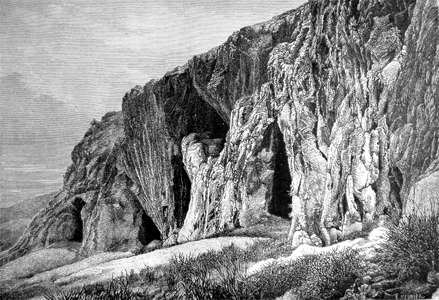
Grimaldi Caves.
The cave of Baoussé Rossé (Balzi Rossi, Rochers Rouges, Red Cliffs), to the east of Menton, engraving by Sorrieu, after a photograph of M. Rivière.
Date: 1877
Source: Wikipedia, via Élisée Reclus, Nouvelle géographie universelle, t.2: La France, 1877, p. 35
Permission: This image is in the public domain because its copyright has expired.

Grimaldi Caves.
The caves of Balzi Rossi today.
From west to east, cave of Fanciulli, cave of Florestano and cave of Caviglione in Ventimiglia area, Italy.
Date 2008-02-20
Photo: Lemone
Permission: GNU Free Documentation License, Versione 1.2
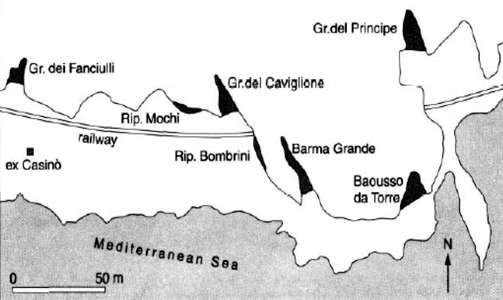
Map of the caves of Balzi Rossi, the Grimaldi Caves.
Photo: Mussi (2002)
The site is composed of a suite of caves and abris which are, from the west to the east, the Grotte des Enfants, l'abri Lorenzi, the Grotte de Florestan, l'abri Mochi, the Grotte du Cavillon, the Barma Grande, the Barma di Baousso da Torre, today destroyed, and the Grotte du Prince, and some adjoining ones, more to the east, caves of secondary importance, which do not seem to have any prehistoric remains.
There have been a number of eminent prehistorians who have undertaken excavations in this area: Émile Rivière between 1870 and 1875, L. De Villeneuve, at the instigation of the Prince of Monaco between 1895 and 1902, Alberto Carlo Blanc from 1938, and finally, Louis Barral of the Musée d'Anthropologie Préhistorique de Monaco, and Guissepe Vicino, of l'Institut International d'Études Ligures.
Text above: Delporte (1993)
Map of the caves of Balzi Rossi, the Grimaldi Caves, in the 19th century.
Photo: Bolduc et al. (1996)
Many of the photos below come from http://www.mentondailyphoto.com/, an excellent blog about Menton, a lovely part of the world. These beautiful photos of the area are a great addition to the site.
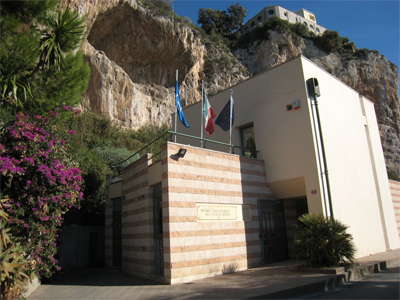

There is a small museum at Balzi Rossi, and from it a path leads up to the caves.
Photo: http://www.mentondailyphoto.com/
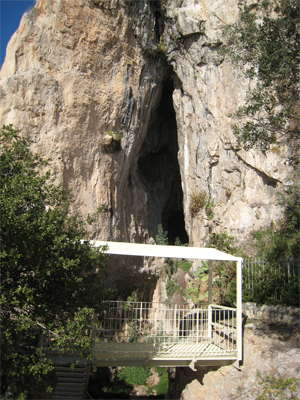
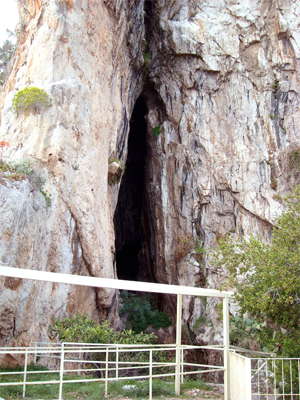
This is the Barma Grande cave where the 'triple burial' was discovered, although it is not possible to visit this cave.
Photo: (left) http://www.mentondailyphoto.com/
Photo: (right) Lemon
Permission: GNU Free Documentation License , Version 1.2
Date: February 20, 2008


The path leads across the pedestrian bridge over the railway tracks to the caves.
Photo: http://www.mentondailyphoto.com/
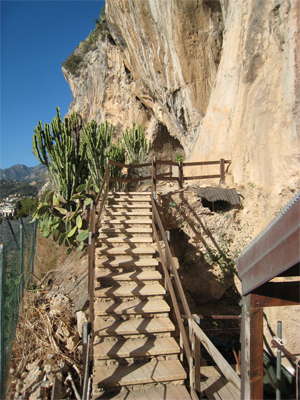

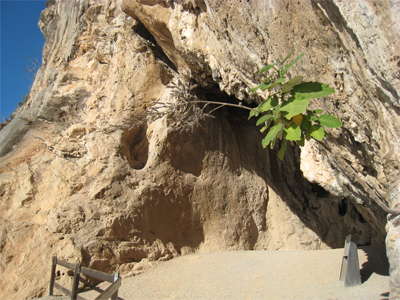
This is the Grotta di Florestano - Florestano's Cave, so named in honor of the Prince of Monaco , who, in 1846 , financed the first excavations. Although there are seven caves at Balzi Rossi, only two can be visited, Florestano's Cave and Caviglioni's Cave.
Photo: http://www.mentondailyphoto.com/

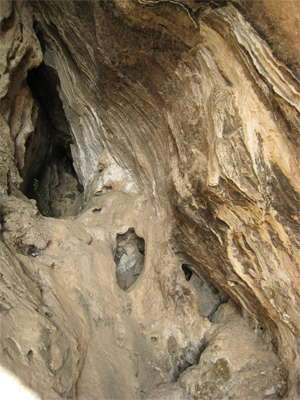
Grotta di Florestano
Photo: http://www.mentondailyphoto.com/

Old postcard of Barma Grande, at a time when it was accessible by the public.
Photo: http://www.mentondailyphoto.com/
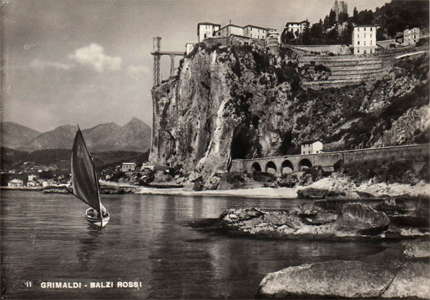
Old postcard of Balzi Rossi, the Grimaldi Caves.
Photo: http://www.ebay.com/
From: http://training.fws.gov/EC/WebSeminarSeries/0320Webinar/Papers/Rykiel_Science-1994.pdf
The Grimaldi ice age figurines were shown in 1914 to George McCurdy of the Peabody Museum at Harvard University by the daughter of the excavator, L. Jullien. In 1939 they were offered for sale to the American Museum of Natural History, who sent photographs to the Peabody Museum. Hallam Movius bought the most important of these for the Peabody, the woman with two faces, the Janus figurine. It is important, not because it is a 'masterpiece', but because it is the only ice age carving depicting two females, one side pregnant, and the other not, thus confirming the presence of both concepts in Ice Age female Imagery.
The long archaeological argument as to whether pregnancy or nonpregnancy were depicted seems to have been settled by my analysis of the figurine published in 1986
The remaining Grimaldi figurines are patently 'crude' carvings. It is likely for this reason that they were not purchased earlier.
Early in the 20th century, museums and collectors were primarily interested in purchasing obvious 'masterpieces'. The best of the Grimaldi figurines had been purchased early in the century for the Musée Antiquitées Nationales in France. Such 'masterpieces' had long shaped archaeological theories concerning the quality and meaning of the so-called 'Venus' figurines.
The new set of Grimaldi figurines may, therefore, be important precisely because of their ostensible 'poor' quality. There are many classes and types of female imagery with different apparent meaings and uses, and one class, patently 'crude' and often relatively quickly made (but not works in progress) was apparently produced for short-term, or even one-time, ritual use.
The 'masterpieces' on the other hand, often show evidence of long-term curation, use, and reuse.
Alexander Marshack, Peabody Museum, Harvard University, Cambridge.
Imagerie féminine du Paléolithique: l'apport des nouvelles statuettes de Grimaldi
Paleolithic female imagery: the contribution of the new Grimaldi figurines
White et Bisson (1998)
This is a wonderful paper by two eminent scholars in the field of Paleolithic imagery, Professor Randall White and Monsieur Michael S. Bisson.
The full paper, of which this is a part, may be seen at: Imagerie féminine du Paléolithique: l'apport des nouvelles statuettes de Grimaldi
Abstract:
Having participated in the re-discovery in Montréal of seven nearly unpublished anthropomorphic figurines from the caves of Grimaldi (Liguria, Italy), the authors present a description and analysis that reunites these seven pieces from the Jullien collection with those from the Musée des Antiquités Nationales at Saint-Germain-en-Laye. They attempt a seriation that yields a provisional chronology within the total collection of statuettes. They then seek an explanation for the statuettes which takes into account the cultural context of their fabrication, use and disposal. With the judicious use of ethnographic analogies, they hypothesise that these objects were used by women to ensure safe completion of pregnancies and safe deliveries of infants, rather than to ensure fertility.
We describe below in detail the full complement of figurines found by Jullien, including new discoveries, as well as the seven currently held in France and the United States. Then we present our observations and analytical results, concluding with a new interpretation that takes into account the common elements of the figures seen in their archaeological context.
Louis Alexandre Jullien was an antique dealer from Marseilles who discovered fifteen small sculptures from the excavations he led between 1883 and 1895 in the caves of Grimaldi, Liguria, Italy , a group of well-known sites of the Upper Paleolithic on the Mediterranean coast adjacent to the French border (Pales, 1972).
For a decade, only his colleague and teacher, Stanislas Bonfils, was aware of these findings and the reason for this silence is still subject to speculation (Bisson, Bolduc, 1994). A contemporary account gives Jullien's reluctance to announce the discovery to the idea that he thought the statues were less ancient (ie Neolithic) and therefore could potentially affect the commercial value of the Paleolithic stone tools of his excavations (Verneau, 1900). According to the archives and publications available to us, we tend to think that the silence of Jullien could partly result from the fact that some of his excavations (Cave of the Prince) were carried out clandestinely.
In other cases (Barma Grande), occasional disputes with the owner of the site about artefacts recovered could easily explain the prolonged silence of Jullien. In 1896, Jullien sold the 'yellow steatite statuette' (Venus of Menton) to Salomon Reinach's Museum of National Antiquities in Saint Germain-en-Laye. Six others (five in 1897 and one in 1903) were sold to the famous pre-historian and collector of Paleolithic art, Edouard Piette, who later left his entire collection to MAN in 1906 (Palestine, 1972).
Jullien's letters written in 1903 to Piette suggests that the seven specimens in France accounted for only a portion of the sample recovered. French archaeologists, in particular the Abbé Henri Breuil, tried to locate the rest of the figures in 1913. These investigations took into account two additional objects from Barma Grande ('The Bust' and 'Woman with Perforated Neck', also known as 'Janus'). Jullien did not reveal the existence of any other specimen to Breuil. This contact with Jullien was interrupted at the beginning of the First World War (Breuil, 1928).
On Jullien's death in 1928, his daughters inherited the figurines and display cases of approximately 500 stone tools from his excavations in the cave of Barma Grande. One of the girls moved to New York and after six years of negotiations, in 1943 sold the 'Woman with the Perforated Neck" and about 380 stone tools to the Peabody Museum of Harvard (unpublished archives at the Peabody Museum).
The rest of the Jullien Grimaldi figurines collection eventually passed to his two granddaughters, who put five anthropomorphic sculptures and dozens of tools on sale in an antique shop in Montreal in the late 1980s. Pierre Bolduc, an artist from Montreal, bought these objects and, after a period of several years, brought them, in October 1993, to McGill University for evaluation and analysis. On our advice, Pierre Bolduc sought the granddaughters of Jullien and found in their home two additional sculptures (including the 'Bust', which an envoy of Breuil had seen and described in 1913).
Although the entire Jullien collection was not known before, the specimens he sold to Piette and Reinach were among the first women of the Upper Paleolithic sculptures to attract the attention of scientists and were immediately subjected to a lively debate on their authenticity (Mortillet, 1898; Reinach, 1898; River, 1898 and 1904; Verneau, 1900; Octobon, 1952). When Breuil certified their authenticity (Breuil, 1928), the sculptures of the MAN Grimaldi figures entered the debate that brought meaning to Upper Paleolithic female imagery, and continues to this day, the debate being raised by the discovery of new specimens. It was the same for the figurines of Brassempouy and Lespugue in France, and Willendorf in Austria, and the similar (in terms of style) sculptures in low relief from Laussel in France.

Fig. 1 - The fourteen Grimaldi statuettes described by White et Bisson (1998):
1. The Couple, or the Double Venus
2. Woman with the perforated neck
3. The Two-Headed Woman
4. The yellow steatite statuette, or the Venus of Menton
5. Pulcinella or the Venus of Polichinelle
6. Brown Ivory Figurine
7. The Venus el Rombo, or Venus de Losange, (the diamond, or rhomboid, or lozenge shaped venus)
8. The Bust
9. The ivory figurine in red ochre
10. The flattened figure
11 The Negroid head
12. The Hermaphrodite
13. The Woman with goitre
14. Undescribed figure
Photo: White et Bisson (1998)
Authenticity
Given the circumstances, and with fake Paleolithic sculptures (from Italy) in circulation (White, 1992b), the question of the authenticity of the newly discovered sculptures has to be taken seriously. Our analysis of the seven rediscovered sculptures took place at the Redpath Museum, McGill University. The techniques used have focused on microscopic and visual inspection, photographyand microphotography, the taking of high resolution impressions of the surface of the stone statues (to identify tool marks) and the removal of sediment adhering to the surface of the specimens. This research, when combined with documents to prove that the specimens were part of the Jullien collection, reassures us that these figurines are of Paleolithic age, although final authentication is waiting on direct comparisons with the specimens at Saint-Germain-en-Laye.
With the Montreal statuettes, the Grimaldi group of figurines is the largest in Western Europe, and the objects themselves, with the exception of one, are well preserved.
Although Jullien left few writings in Canada of their archaeological context, we have obtained his original records sent to France in the early twentieth century. These documents, coupled with our own detailed analysis of the objects themselves, have enabled us to make significant progress in terms of rebuilding their timeline and authenticity, and to identify with some certainty the specific sites where they were found. The number and variety of these documents provide a unique opportunity to better understand this topic.
These documents will be reproduced in full in our monograph on the sculptures of Grimaldi, which requires a good knowledge of their archaeological context. Therefore, before discussing interpretations concerning them, we begin by briefly illuminating the entire sample of Grimaldi and consider their dating and likely stratigraphic associations.
Archaeological Context
Jullien is known to have excavated in three places in Grimaldi. Barma Grande was his authorised search and the largest, from which he removed about 7 metres depth of deposits near the entrance to the cave in the space of only four months. In the la Grotte du Prince, he conducted excavations from 1892 to 1895 and finally, at an unknown date, dug a trench more than 3 m deep in le Jardin Abbo, a terraced vineyard west of Barma Grande located (according to a notation in Jullien's hand on a flint tool collection in the Redpath Museum) 'between the second and third cave and the sea'.
Analysis of his correspondence published by Dr. Léon Pales (1972) argued that most of the figurines came from a single cache discovered during the secret excavations by Jullien in the Grotte du Prince, but Dr Pales had no opportunity to consider the collection of Montréal, then unknown. Our visual comparison of the sediment stuck to the statuettes and analysis of the remaining Jullien records suggest that the figurines had been discovered in three locations (i.e. Grotte du Prince, Barma Grande and Jardin Abbo). In addition, the analysis of the stone tools of the Jullien collection, and radiocarbon dates recently obtained from the product of his excavations at Barma Grande (Bisson et al, 1996; Bisson, Del Lucchese, in press) indicate that the initial production of these works by the artists could extend over a period as long as 5 000 years.
Description of the Objects
Table I presents the figures according to what we believe to be the order of their seniority and their site of origin, although this may be modified by future research. We find complete descriptions of the figurines found in Bisson and Bolduc (1994).
| Name | Material | Length (mm) | Head | Torso upper part |
Torso lower part |
Genitals | Legs | Ochre | Pierced? |
|---|---|---|---|---|---|---|---|---|---|
| Jardin Abbo | |||||||||
| Figurine in brown ivory | Fossil Ivory | 67.6 | oval, absence of facial and hair features | no arms, breasts and buttocks rounded | protruding abdomen and buttocks | horizontal projection (labia?) | cut off at the knees | no | no |
| Grotte du Prince | |||||||||
| Figurine in ivory with red ochre | ivory | 75.0 | oval, absence of facial features, thick hair | elongated breasts, no forearms | protruding abdomen and buttocks | accentuated pubic triangle | cut off at the knees | thick on the head and torso | between the breasts |
| Polichinelle | stone | 61.0 | pointed, lateral compression, lack of facial features and hair | elongated breasts, no forearms | protruding belly circular in shape, protruding buttocks | vulva open, gynecological perspective | tapering | trace | no |
| Losange | stone | 61.0 | sharp, lack of facial features, groove marking the outline of the hair | elongated breasts, no arms | protruding belly circular in shape, wide hips, buttocks flattened | vulva open, gynecological perspective | tapering | trace | no |
| Woman with two heads | stone | 27.5 | ovoid, lack of facial features, groove marking the outline of the hair | elongated breasts, no arms | protruding belly circular in shape, protruding buttocks | vulva open, gynecological perspective | terminating above the knees | trace | between the two heads |
| Double figurine | stone | 47.2 | head flattened, facial features erased, groove marking the outline of the hair | 'goiter', no arms, breasts with tips pointing down | protruding abdomen and buttocks | vulva open, gynecological perspective (partial) | bent at the knees | trace | between the two heads |
| Undescribed figurine | stone | 37.5 | ovoid, lack of facial features, groove marking the outline of the hair | elongated breasts, no arms | front side prominent, protruding buttocks | missing | present | no | |
| Hermaphrodite | stone | 52.0 | missing | elongated breasts, no forearms | belly protruding, swollen at the front of the hips | bulging with fine vertical cuts | broken above the knees | no | no |
| Negroid head | stone | 24.0 | head without body, face finely carved, thick hair | no | no | ||||
| Barma Grande | |||||||||
| Woman with perforated neck 'Janus' |
stone | 62.0 | flat, circular, eyes and mouth carved on the front and back of the head 'hood' |
no forearms, oval-shaped breasts | prominent belly, buttocks flattened | vulva open (small) | complete, knees and feet indistinct or absent | trace | through the neck |
| Bust | stone | 29.2 | flat, circular, carved eyes, nose sculpted, outline of the hair or a 'hood' | no arms, pointed and oval-shaped breasts | missing | trace | no | ||
| Flattened figure | stone | 44.2 | flat, circular, lack of facial features, fine cuts marking the hair and the outline of the hair | long arms defining the torso, breasts absent | flat belly and buttocks, but with rounded margins | small notch representing the vulva, gynecological perspective | ending below the knees | trace | through the neck |
| Statuette in yellow steatite Venus de Menton |
stone | 47.0 | ovoid, lack of facial features, a lock of hair down the back | no forearms, rounded and very large breasts | prominent belly, wide hips | not indicated | terminating above the knees | no | no |
| Woman with goitre | ivory | 45.0 | ovoid, lack of facial features | no arms, breasts conical, tips pointing down, 'goiter' | prominent belly, wide hips, buttocks flattened | vulva open, gynecological perspective | broken below the vulva | no | no |
| Face | stone | 23.2 | image flattened, nose, eyes and mouth stylised | trace | through the eyes and mouth | ||||
The 'Bust'

Fig. 2 - Front view of the 'Bust' (coll. Lavigne)
Scale: 5 mm.
Photo: R. White
Source: White et Bisson (1998)


Colours shown here are Munsell = 5G 3/2, dusky green (left) and 5BG 3/2, dusky blue green (right).
rgb equivalents (on the 0-255 scale) 61, 76, 71 to 58, 78, 87
Data from http://www.perbang.dk/
The 'Bust' is the only carving in the collection which was rediscovered in Montreal already known to the scientific world. In 1928, a few photographs and sketches made by the Abbé Dupaigne were published by H. Breuil. He attributed it to the collections at the Grotte du Prince and it was understood until today (Mussi 1991), that its discovery was made by L.-A. Jullien. We now know that this is not correct. A label affixed to the piece, written in the hand of L.-A. Jullien, says 'Barma Grande, Cavilieri, Menton.' Cavilieri was a little known collector except for the fact that he searched the cave of Barma Grande at about the same time as Jullien.
The label suggests that the 'Bust' was discovered by Cavilieri, and later acquired by Jullien. Some indices lend particularly strong credence to this interpretation. The University of McGill in Montreal has more than 900 objects (lithic industry and fauna) attributed to Upper Paleolithic from Barma Grande cave and la Grotte du Prince (acquisition from L.-A. Jullien in 1896 and in 1926 H. Ami ). An analysis by eye of the sediment still present on these objects allows us to assign the 'Bust' to the cave of Barma Grande. Indeed, the grey sand still partially covering the piece is not visible on the objects in the Grotte du Prince but is found on 36% of archaeological material from Barma Grande.
This sculpture represents the head and upper torso of a female (Fig. 2). The right breast has disappeared and this break probably dates from the Paleolithic period. It is made of the same material as the first 'Woman with a perforated neck" kept at Harvard. It is made of a dark green chlorite (Munsell value = 5G 3 / 2 to 5BG 3 / 2 (dusky green to dusky blue green, rgb 61, 76, 71 to 58, 78, 87 )). It measures 29.2 mm in height and has a maximum thickness of 9 mm and a weight of 8.07 g. The drawings that H. Breuil made from the photograph of Abbé Dupaigne (Mussi 1991; Delporte 1993b) give the impression that the object is broken under the breast, but in truth it is now complete with the exception of the right breast and small accidents at the top of the upper limbs. These breaks are certainly due to a weakening of the surface areas along the natural cleavage of the raw material. Chlorite is often soft and this piece was certainly very brittle when it was first discovered.
The end of the left breast shows a thin abrasion and does not carry any trace of sediment, while it is found in most of the depressions in a consolidated state as what seemed at first like a layer of lacquer. Following careful examination by binocular microscope the solidification of the sediment appears to be the result of natural processes and not a chemical treatment by Jullien. Mcroscopic traces of red ochre were also found 'trapped' under the grey sand at the bottom of incisions present on the surface. the friable status of certain sectors does not allow us to determine the degree of original abrasion. However, the smoothness of the lower torso suggests that at one time the surface was finely abraded.
The head of this statue is circular, the face is highlighted on a flat field (a very common among the statuettes of Grimaldi) and is bounded by a narrow incision, when viewed in profile, it is slightly convex.
The upper part is distinct, and the chin line and the square chin are sculpted with care. Perhaps he had other facial features carved that have disappeared over time. His eyes represented by two horizontal incisions of 3 mm. If the nose there, it is still more than the share ie high between the eyes.
Unlike the face of the 'Woman with a perforated neck', the face of 'Bust' does not have an incised mouth. In its place is a natural clearer area in the chlorite. The arms are not represented. The intact breast is, from the front, a pointed oval, and in profile, slightly flattened. A notch between the breasts makes them appear prominent. This figurine has a flat back marked by rather irregular grooves with a U shaped profile. They are oriented more or less vertically to the axis of the piece, but the label affixed by Jullien partially covers them.
The 'Flattened figure'
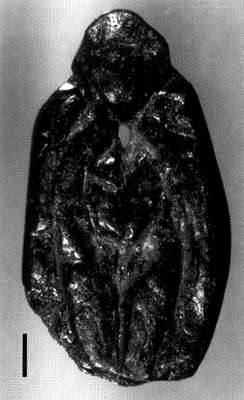
Fig. 3 - Front view of the 'Flattened Figure' (coll. Bolduc)
Scale: 5 mm.
Photo: R. White
Source: White et Bisson (1998)
From the front, this piece appears as an irregular oval on a flat surface. All anatomical details are incised or engraved on the surface to make the figure. A hole was cut in the neck for a cord.
The statuette is made of the same material, chlorite, as the first-mentioned 'bust', but the texture is finer and the support is thinner, making the piece less fragile (without a line of cleavage) and allows a little smoother polishing. No fresh fracture is visible. Rough surfaces present on the extremities of the upper and lower members may correspond to a break during the manufacture or the original surface of the original material.
Slight abrasion and the rounded appearance of these surfaces could be taken as proof of an attempt at reparation after the break, but it is not. Under the binocular microscope, these rounded surfaces show fine abrasion (with visible striations) rather than a polished surface (stripes not visible). No trace of sediment has remained on the statue, but fine particles of haematite are still present in natural depressions and cuts on the surface. Has Haematite has been used as a polish in order to give lustre to the piece, or, more likely, in order to cover it with red ochre?
The total length is 44.2 mm, width is 27.6 mm and thickness is 8.5 mm. The weight is 14.007 g.
This simple female representation and its crude shape has much in common with the "bust" in addition to the raw material.

Fig. 4 - Similar fine incisions:
(left) Abdomen of Polichinelle (coll. MAN)
(right) Head of the Flattened Figure (coll. Bolduc)
Photo: R. White
Source: White et Bisson (1998)
Thus, we can see the circular shape of the head with the face defined by an incised line. The area around the face is flat while the face itself is slightly convex. No line appears with the exception of two small depressions in place of ears. Two parallel incisions made with a cutting tool delimit the top of the head on the face and the back of the specimen. The area between these two lines is covered other incisions perpendicular to the first. This series of incisions, more or less subparallel, is perhaps the hair (Fig. 4, right). The head is hunched into the shoulders and distinguished by two deep grooves which converge into a V shape and terminate in a perforated oval under the chin. The shoulders are unusually broad and carry two deep triangular notches in the deltoid muscles. The arms are distinguished from the bod by long incisions follow the curves of the figure to mid-thigh. Elbows, forearms and hands are not represented. The upper limbs terminate simply with a rounded surface. At the far end of the arms, the stone was scraped and left without fine polishing to make distinct the contours of the thighs. The contour of the torso is incised, and, viewed from the front, has a circular shape. The treatment of the left margin of the torso is slightly different from that of the right margin.
The breasts (Fig. 5), abdomen and buttocks cannot be seen to be prominent. The abdomen is wider than the chest. A small depression indicates the navel. The pubic triangle is wide and deeply incised. The deepest cut is slightly crooked on the left. This last is probably the vulva, even if its representation is more ambiguous than those observed on other Grimaldi specimens. The lower limbs are separated by another incision. Unusual and unique details appear on the thighs. At the front, a rather fine line is incised longitudinally in the centre of each thigh.
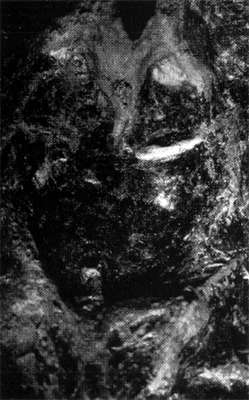
Fig. 5 - Detail of the breasts of the Flat Figure (coll. Bolduc).
Photo: R. White
Source: White et Bisson (1998)
The back of the pendant is finely abraded. Irregular incisions forming a converging Y emphasise the lower neck, and meet the perforation. Other incisions, less distinct, forming a Y also emphasise the buttocks and mark the separation between the legs. The gender of this figure is difficult to determine because the secondary sexual characters are less pronounced than on most of the sculptures of Grimaldi. Thus, the head resembles that of the 'bust' or 'Woman with a perforated neck' of Harvard. These are definitely female.
However, the chest is quite different because it is not prominent. Similarly, the female genital area seems to be less pronounced than on other specimens. Nevertheless, the flattened appearance of the piece may be due to the initial form of the material.
The chest has been rendered by deeply etching the outline. This technique was used for Laussel in the piece called "the Playing Card" We believe that this figure, constrained by the shape of the stone used, is that of an adult woman, but it is not impossible that it is a representation of an adolescent.
The 'Brown Ivory Figurine'
This statuette is a figurine in almost completely mineralised ivory. Its height is 67.7 mm. The width at the chest is 17.2 mm and 20 mm at the hips. The maximum thickness between the buttocks and the front of the belly is 22.7 mm. Its weight is 19.37 g (Fig. 6).

Fig. 6 - Front view of the Figurine in Brown Ivory (coll. Bolduc).
Scale : 5 mm.
Photo: R. White
Source: White et Bisson (1998)


Colours shown here are Munsell = 2.5YR 5/8, Moderate orange red (left) and 5YR 5/8 Moderate orange (right)
rgb equivalents (on the 0-255 scale) 183,101,66 and 178,104,54
Data from http://www.perbang.dk/
Because of the yellowish color of this piece (Munsell = 2.5YR 5/8 to 5YR 5/8, Moderate orange red to Moderate orange), it is difficult to say whether there are traces of ochre on the surface. Cracks due to drying of the raw material and filled with dark sediment, are visible on the head and the legs (back and bottom). The only injury suffered by the statue is a small broken area on the tip of the right breast.
When viewed from the front, the head is almost circular (Fig. 15, No. 1). It is not tilted slightly downwards as can be seen on some other female figures (Delporte 1993b). No facial features or representation of the hair is visible. The back of the head is narrower than the front. A deep polished groove on the back of the neck emphasises it. This groove continues to the front of the neck, marking the shoulders and suggesting the clavicles. There are neither arms nor hands. The breasts are irregularly hemispherical and separated from each other by a deep groove.
The back of the chest is flat with a shallow incision indicating, perhaps, the region of the spine. The waist is formed by a broad depression. The abdomen is oval, and is much more prominent than the breasts. It is marked off from the hips by two lateral incisions. The volume of the buttocks is very broad and they appear spherical seen from behind. They are separated by a deep but very narrow incision. The lower limbs are well shaped. The break at the knees apparently dates from the prehistorical period.
The pubic area is very unusual. Most of the statuettes of Grimaldi have a protruding mons pubis of exaggerated size with a groove or a vertical incision showing the vulva. In this piece, a deep U shaped groove, 8.5 mm wide, runs from mid-thigh to crotch. In the centre of this groove, just below the abdomen, is a small elongated horizontal slightly curved ridge. This ridge, which has not been completely cleaned of sediment, is in the place where the labia minora would be. This way of representing the genitalia has not been previously observed in other female figures of Upper Paleolithic Europe.
The Ivory Figurine in Red Ochre - The Ochre Lady
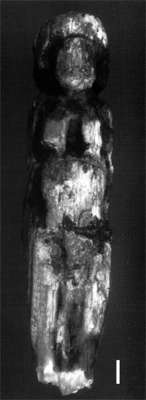
Fig. 7 - Front view of the Ivory Figurine in Red Ochre (coll. Bolduc).
Scale : 5 mm.
Photo: R. White
Source: White et Bisson (1998)
It is a female figure made of a non-fossilised mammoth tusk (Fig. 7).
The lower limbs are partially broken, but the piece is relatively complete, although, because of its very friable surface, there is exfoliation on the back of the head, lower limbs and buttocks . There is evidence showing that it was covered with a protective diluted varnish in order to consolidate a large crack extending across the right side, an area of weakness due to the 'puff pastry' structure of the ivory.
The head and body of the statue were originally covered with a thick layer of red ochre (Fig. 8). The colour of the piece is between dark red and red-brown (Munsell = 2.5YR 2.5/2 to 5YR 3/4). The surface was also polished in the Paleolithic. Where the surface is exfoliated, the original color is white.


Colours shown here are Munsell = 2.5YR 2/2, Dark grayish reddish brown (left) and 5YR 3/4 Brown red (right)
rgb equivalents (on the 0-255 scale) 66, 44, 42 and 102, 63, 45
Data from http://www.perbang.dk/
However, applying a protective varnish has created an ochre stain on the non-exfoliated areas, creating reddish zones. Other accidents are visible in this statue, like the loss of the tip of the left breast, and an area from the top of the upper arms to the bottom of the lower legs. There is a corrugated surface on the right leg as well as a break in the lower legs dating perhaps from the excavations. The piece measures 75.2 mm long.
The width of the head is 16.9 mm, the width at the level of the breasts is 12.9 mm, and the width of the hips is 18.4 mm. The maximum width of the piece, taken between the buttocks and the abdomen, is 21.6 mm. It weighs 1 995 g (? This seems to be a typo. Probably 19.95 grams - Don)
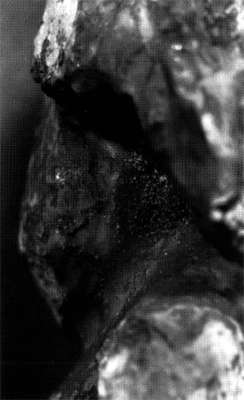
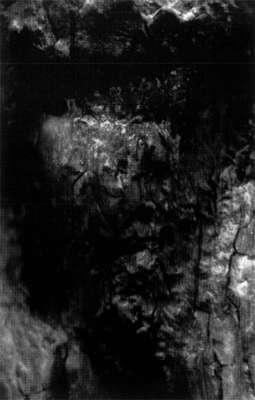
Fig. 8 (left) - Profile of the head of the Ivory Figurine in Red Ochre highlighting the thick deposit of ochre. (coll. Bolduc).
Fig. 9 (right) - Detail of the pubic triangle of the Ivory Figurine in Red Ochre showing the deep incisions and erosion of the surface (coll. Bolduc).
Photo: R. White
Source: White et Bisson (1998)
The head is erect and there are no lines on the oval face. (Fig. 15, No. 2). The hair is clearly marked (Fig. 18, No. 2). The hair forms a thick hairstyle framing the face and ending in two sharp points on the back of the shoulders. The front and back of the hairstyle are separated by a series of incisions aligned end to end. The front carries no detail. The back, however, has vertical lines that appear to be hair. On the torso, the upper limbs are gone, but their outlines remain. They give the impression that the upper limbs were flexed.
The breasts are oblong in shape and appear cylindrical in profile. They do not rest on the abdomen. A deep groove separates the two breasts and extends to the hole at the base of the chest. This hole, carefully drilled, forms an angle with the axis of the piece. It piercers the figure from front to back and ends higher at the back in a large conical hole. Red ochre is in this hole, suggesting an application of the ochre in a liquid form.
The abdomen is round in shape and more prominent than the chest. The pubic triangle is bounded by three large incisions (Fig. 9). Its shape is a pronounced bulge, with a slightly conical profile and tapering towards the bottom.
Its surface is in too poor a condition to allow many other observations. The vulva is not indicated. The hips are wide. The buttocks are protruding, hemispherical and lack a groove of separation. The lower limbs are schematic and slender in profile, and concave when viewed from behind.
The Double Figure
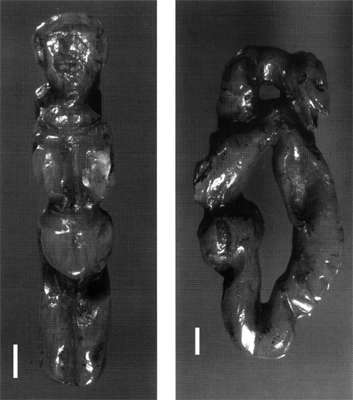
Fig. 10 - View of the front (left) and profile (right) of the Double Figure (coll. Bolduc).
Scale: 5 mm
Photo: R. White
Source: White et Bisson (1998)
The Double Figure is the most complex part of the Grimaldi collection (Fig. 10). This is a small pendant with a female representation back to back with that of an animal.
The two figures are attached at the back of the head, at the shoulders and at the feet of the female figure.
This piece is made in a yellow-green serpentine (Munsell = 2.5GY 6/6 - 2.5GY 6/8) (rgb 151, 154, 78 to rgb 149, 155, 43 Greyish Olive and Moderate Olive) and is highly polished.


Colours shown here are Munsell = 2.5GY 6/6, Greyish Olive (left) and 2.5GY 6/8 Moderate Olive (right)
rgb equivalents (on the 0-255 scale) 151,154,78 and 149, 155, 43
Data from http://www.perbang.dk/
Little sediment remains after cleaning by Jullien. However, traces of haematite are visible under a microscope. A small amount of clear sandy sediment of fine grain is visible in the hollow of the knees of the female figure and in her mouth.
Discolouration in the bottom of some incisions appears to be due to Manganese dendrites often found in karst. The total length of this pendant is 47.2 mm and it is 23.2 mm thick. The width taken at the breast of the female figure is 10.4 mm. The weight is 11.42 g. The human figure has the head raised and a very arched back which allows the projection of the breasts and a very prominent abdomen. In profile, the head is flattened from front to back.
From the front, it is almond-shaped with a broad forehead and a high and narrow chin. The face, flattened, is framed by a series of finely chiseled features of the front to back through the temples. The face itself is unusual in the sense that it was purposely removed by chiseling. A small pecked out oval, which may indicate the mouth, has been partially shown. A line has been engraved on the neck just below the chin. Given the high quality of execution of the entire piece, it seems unlikely that marks observed on the face and neck are due to a mistake by the sculptor.
At the base of the narrow neck is an oval relief divided into two parts by a vertical incision (Fig. 16, No. 3). This is very similar to that observed on another figurine in the Grimaldi collection, the Woman with Goitre, kept in the Musée des Antiquités Nationales (MAN) at Saint-Germain-en-Laye. Below this can be seen a wide horizontal groove that creates a flattened area at the top of the chest. The breasts are cylindrical and hang down, but do not descend below the waist.
A little material is missing on the left breast. This is probably an accident during manufacture.
Identification of the arms of this figure is problematic. No arms extend down the sides of the torso as is often the case for the representations of females in the Grimaldi collection. It is possible that at the level of the shoulders, where the two figures come together, the two limbs coming down along the body of the animal are in fact the human arms. However, they are very thin, not necessarily in human form and placed in a high, unnatural position. They could be, just as well, the forelegs of the animal, and in this case the human figure has been portrayed without arms.
The abdomen, wider than the hips is protuberant. A navel is engraved in the centre. On each side of the abdomen, one can see a wide vertical line etched. The left line is more pronounced than the right. On the right side, there is a natural defect of the stone. The pubic triangle is rendered in detail, with a vertical incision representing the vulva. The buttocks are large but not as pronounced as for other copies in the collection because of the small space between the backs of the female and animal figures.
A vertical fold splits the buttocks, and the upper thighs are shown. The Double Figure is different from the other Grimaldi pieces, also because the legs are detailed. In profile, it seems that they are strongly bent, and the feet are close against the buttocks. Details of the ankle and foot are shown on the right, but are more schematic on the left. Always seen in profile, the body of the animal is attached at the feet of the woman. Looking at the animal figure from the front, and therefore at the back of the human, the legs are more ambiguous. The incision that separates the two legs does not extend beyond the knees and thus the demarcation between the legs and the feet is not obvious.
The animal in this piece has a detailed head but a stylised body, difficult to interpret. The head is not attached to the body by the neck, but by a piece of material between the back of the animal's head to the female body. The muzzle is long and pointed with tiny incisions at the end indicating the nostrils (Fig. 16, No. 4). Eyes, two small circular holes, are towards the back of the head. An incised horizontal line marks the top of the face. Two small triangular ears are engraved at the top of the head. The open mouth extends all along the muzzle. Small superficial holes are placed at the corners of the mouth and on the lower surface of the jaw (in the mouth of the animal).
If the head and body are one and the same animal, the head is very much projected beyond the shoulders, in an anatomically unrealistic position. The body of the animal is in the same stance as that of the female figure. Seen from the left, this is mostly a curved and irregular cylinder, with sixteen incisions across it, placed diagonally at irregular intervals. The deepest of these incisions is directly under the head and seems to be the dividing line between the realistic face and its more stylised body. The forelimbs, as described above, seem absent.
There is no representation of the tail or hind legs. A wide and deep vertical groove descends to the lower part of the body. To the right of this line, the piece is heavily abraded and has no detail. The identification of this animal remains problematic. If you look closely the face it is more a mammal than a reptile. In fact, the head is probably of a carnivore. A long snout, large mouth, triangular ears and eyes set at the top of the head are typical of carnivores. This very elongated snout seems to preclude the idea of a cat. A canid (fox or wolf) is possible, as is a mustelid (marten or badger). If the elongated body is the same animal as the head, a small carnivore (canine or mustelid) seems the most plausible representation.
The 'Two-Headed Woman'

Fig. 10 - Profile of the Two Headed Woman (coll. Lavigne).
Scale: 5 mm
Photo: R. White
Source: White et Bisson (1998)
This little pendant is made of the same yellow-green serpentine as the Double Figure. It is the smallest of the entire collection of Grimaldi figurines, with a length of 27.5 mm, a maximum thickness of 12 mm and a weight of only 1.85 g (Fig. 11). Its surface is highly polished and has been thoroughly cleaned. However, traces of red ochre are still visible in the incisions. Microscopic traces of manganese (brown?) stain the abdomen and retain a fine grain sand, yellowish grey.
A fibrous, waxy mass is located in the hole between the two heads. This could be the remnant of a substance used by Jullien during cleaning. A break at the waist, probably caused during excavation, was re-glued. Apart from this restoration, there has been no recent change to the figure. The head is ovoid, 5 mm long and projects forward. No facial feature is represented (fig. 15, No. 3).
A deep incision marks the top of the forehead, while others, which are perpendicular, represent the line of hair. These incisions join another, deeper line, which marks a small serpentine 'bridge' linking the two heads. This second head is in the opposite direction to the first, but in the same attitude. Its shape, an oval slightly larger than the first, has no features marked. Only two parallel incisions appear on the back of the head, at the spot where it is in connects to the other.
Between the two heads, there is an oval hole for suspension measuring 3 mm by 1.8 mm. The neck is formed by a deep abraded groove. The torso is narrow with a width of only 5.5. The upper limbs are absent. The breasts are conical and project forward. They are extremely large (7.9 mm) and extend laterally beyond the edges of the torso. The right breast is unmarked but, on the left, there are two incisions in a circle (?) and a puncture hole.

Fig. 12 - Microscopic view of the abdomen of the 'Woman with Two Heads' showing the navel and the polished surface, perhaps glazed. (coll. Lavigne).
Photo: R. White
Source: White et Bisson (1998)
The back is flat and an incision at the centre could indicate the spine. The waist is small. The hips are wide. On the hips, a deep but narrow incision, is located at a level at the middle of the abdomen. These features are almost identical to those visible on the abdomen of the 'double figure'. The centre of the abdomen is protruding and almost perfectly round, with a small pecked belly button in the centre (Fig. 12). The base of the buttocks is marked by a slightly curved and horizontal incision. A puncture hole is present approximately at the position of the anus. The pubic triangle is very wide and the vulva is indicated by a vertical incision. The lower limbs are separated by a lightly marked incision on both sides that thins out towards the knees.
The Figure, or The Mask

Fig. 13 - Front Views (top) and rear (bottom) of The Figure (coll. Bolduc).
Photo: R. White
Source: White et Bisson (1998)
This object is an oval disk perforated in the shape of a flat face or mask (visible on each side). It is made of a transparent chlorite ranging in colour from green-yellow to yellow (Munsell = 5Y 5/6 to 7.5GY 5/6, rgb 146, 120, 48 to 100, 132, 74, Moderate Amber to Grayish Chartreuse Green). Variations in colour and transparency make it difficult to read the details in dark areas. The piece measures 19.1 mm from forehead to chin, it is 23.2 mm wide and the thickness varies between 3 and 5 mm. Its weight is 2.80 g (Fig. 13).


Colours shown here are Munsell = 5Y 5/6, Moderate Amber (left) and 7.5GY 5/6 Grayish Chartreuse Green (right)
rgb equivalents (on the 0-255 scale) 146, 120, 48 and 100, 132, 74
Data from http://www.perbang.dk/
Despite the cleaning by Jullien, tiny traces of fine-grained yellow sand were detected in a groove. Microscopic traces of red ochre, like a red sediment, were preserved in many incisions. The front of this piece is extremely abraded. In profile, the surface is flat, except for the centre, where, a well shaped 'bulb, represents a flattened nose. The eyes and mouth are perforations in the piece. The eyes are roughly circular and measure 2.4 mm in diameter. There are small lateral notches formed in the upper corner of the eye. These give the figure a look more animal than human.
Two series of parallel incisions cover the cheeks. A deep circular hole is located in the center of the forehead. Other incisions radiate from the hole, especially above the forehead. This hole is empty, but it may well have contained an inclusion or perishable materials. The upper part of the forehead is delimited by a broken line. The area between the wide nostrils is raised. The mouth, with a broad and deep incision, appears slightly upturned.
On the other side of the piece there are no facial features. Apparently it was not meant to be seen. A series of large holes at the level of the eyes and mouth corresponds to what may be a surface preparation: thinning to facilitate the notches for the eyes (?). A deep horizontal incision occurs on the upper part of the piece without any apparent function. What this represents is uncertain.
The radiating incisions on the forehead as well as on the cheeks are not commonly found details on the faces of the Grimaldi and Brassempouy figurines (Delporte 1993b). Thus, this type of line could indicate a face covered with hair. Eyes, nose and mouth have a vaguely feline appearance, but the lack of ears makes interpretation uncertain. This could be a stylized human or animal. Also note that this type of representation is the only one ever found so far in the Epigravettian. From this point of view, this specimen should be treated with caution.
Variability of the female Grimaldi figures
The most striking thing about the 13 female figures of Grimaldi is their variability. Despite the similarities that can enable the grouping of two or three pieces, no two pieces are completely identical. To see if there are common recurring themes, we have registered, for each statue, the characters in 17 distinct anatomical and technical criteria (Table II).
In Tables III to VI, a first approach by two pair of statuettes was performed: first for all of the criteria, then, taking into account only the head and body, and finally in relation to the secondary characters that are the hair, facial features and other body markings.
In Tables III to VI, an initial approach with two pairs of statuettes was performed: first for all of the criteria, then, taking into account only the head and body, and finally in relation to the secondary characteristics which are the hair, facial features and other body markings. Serial ordering was conducted to identify the degree of recurrence in different female representations of the Grimaldi collection Grimaldi.
This method originated in the work of C. Renfrew and G. Sterud (1969). Here we summarise the results of these tests. The similarity matrix for all criteria can be arranged in a very imperfect serial ordering. For a serial ordering or seriation to give usable results there must be a single factor, such as a change over time, as the cause of the variation. We suggest that this failure in obtaining a clear and eloquent serial ordering, may be due to multiple factors coming into play. These factors must include the changes in iconography and/or style over time, as the latest dating shows that these pieces could have been produced over a period of more than 5 000 years. But they also may include changes in the social or individual expression for the production of statuettes, the factors involved varying at the same time.
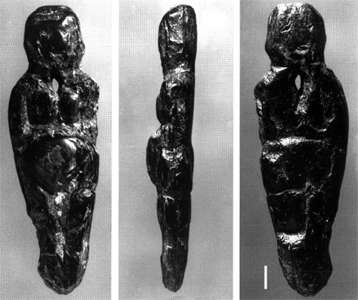
Fig. 14 - Front Views (left), profile (centre) and rear (right) of the 'Woman with perforated neck.' Note in this picture the clear indications of the height of the buttocks (coll. Peabody Museum, Harvard). Scale: 5 mm
Photo: R. White
Source: White et Bisson (1998)
We can not yet draw conclusions about the total influence of the time factor in the serial ordering, because the stratigraphic positions of most of the figures remain unknown. However, we know that at Barma Grande, the 'Woman Perforated in the neck' was discovered at about 6 m depth (Fig. 14)and the 'yellow steatite statuette' (The Venus of Menton) was located between 4.2 m and 4.7 m. As for the 'Woman with goitre', its position was between 3 m and 4.2 m (Bisson et al, 1996). The seriation confirms that chronological order. Thus, if the chronological relationships highlighted by the seriation are what we also know for certain pieces, we can infer the chronological position of others. By this measure, the 'Hermaphrodite' and "Figure in Red Ochre" would be the oldest.
The 'Two-Headed Woman' and 'Double Figure' would, in turn, be the most recent. By retaining seriation made on the general physical characteristics or the secondary characters (hair, facial features and so on), the most relevant criteria and the relationships between them emerge. In the first seriation, there is a consistency in the treatment of the body and head (Fig. 15-17). However, in terms of secondary characters, no order appears. The only reconciliation possible, taking into account these secondary endpoints, can be made between the 'Punchinelle' and 'Diamond'.
The 'Double Figure' can be compared with these two pieces because it has very little in common with the rest of the collection. By focusing the comparison on the general morphology of the body of statuettes, one can identify four distinct groups. The 'Hermaphrodite' and 'Figure in Red Ochre' form the first. They share a number of characters which set them apart from the rest of the figurines in the collection. And that, even if the absence of the head to the 'Hermaphrodite', unlike material and the presence of a suspension for one of them prevent an absolute comparison. The 'Woman with the perforated neck', the 'Flattened Figure' and the 'Bust' are very close with respect to the raw material, the morphology of the skull and the compression in the dorsoventral direction.
1 - Original Material
|
with a ridge in the lower abdomen
|
| Anatomical Criteria | |||||||||||||||||
|---|---|---|---|---|---|---|---|---|---|---|---|---|---|---|---|---|---|
| 1 | 2 | 3 | 4 | 5 | 6 | 7 | 8 | 9 | 10 | 11 | 12 | 13 | 14 | 15 | 16 | 17 | |
| Figurine in brown ivory | 4 | 1 | 1 | 1 | 2 | 1 | 1 | 1 | 3 | 1 | 1 | 1 | 2 | 1 | 2 | 1 | 4 |
| Figurine in red ochre | 4 | 3 | 1 | 4 | 1 | 1 | 2 | 3 | 2 | 2 | 1 | 1 | 3 | 2 | 6 | 1 | 1 |
| Flattened figure | 2 | 5 | 1 | 3a | 1 | 1 | 1 | 2 | 1 | 3 | 1 | 1 | 4 | 4 | 5 | 2 | 1 |
| Bust | 2 | 5 | 2 | 2 | 1 | 1 | 1 | 1 | 2 | 1 | - | - | - | - | - | - | - |
| Woman with two heads | 3 | 1 | 1 | 3b | 2 | 1 | 1 | 4 | 4 | 1 | 1 | 1 | 1 | 2 | 4 | 1 | 5 |
| Double figurine | 3 | 4 | 2 | 3a | 2 | 2 | 1 | 4 | 4 | 1 | 1 | 1 | 5 | 2 | 4 | 2 | 3 |
| Woman with the perforated neck | 4 | 5 | 2 | 2 | 1 | 1 | 1 | 2 | 2 | 2 | 1 | 1 | 1 | 4 | 5 | 1 | 5 |
| Statuette in yellow steatite | 1 | 1 | 1 | 5 | 2 | 1 | 1 | 1 | 3 | 2 | 3 | 1 | 1 | 3 | 1 | 1 | 1 |
| Polichinelle | 1 | 2 | 1 | 1 | 2 | 1 | 1 | 1 | 2 | 2 | 1 | 1 | 1 | 1 | 3 | 2 | 2 |
| Losange, or Rhombus, or Diamond | 1 | 2 | 1 | 2 | 2 | 1 | 1 | 1 | 2 | 2 | 3 | 1 | 1 | 3 | 3 | 2 | 2 |
| Hermaphrodite | 1 | - | - | - | 2 | 1 | 1 | 1 | 2 | 2 | 1 | 2 | 3 | 3? | 6 | - | 1 |
| Woman with goitre | 5 | 1 | 1 | 1 | 2 | 2 | 1 | 1 | 4 | 1? | 3 | 1 | 1 | 4 | 3 | 2 | 2 |
| Undescribed figurine | 1 | 1 | 1 | 2 | 2 | 1 | 1 | 1 | 2 | 2 | 3 | - | - | 2 | - | - | - |
Varying combinations within the anatomical criteria selected. All variables are expressed in relation to anatomical criteria for each statue. The list of attributes and variables is given in Table II.
| a | b | c | d | e | f | g | h | i | j | k | ||
|---|---|---|---|---|---|---|---|---|---|---|---|---|
| a | Hermaphrodite | - | 2 | 1 | 1 | 2 | 2 | 2 | 2 | 1 | 0 | 1 |
| b | Figurine in red ochre | 2 | - | 2 | 2 | 2 | 2 | 3 | 3 | 1 | 3 | 0 |
| c | Figurine with perforated neck | 1 | 2 | - | 2 | 1 | 2 | 2 | 1 | 0 | 2 | 1 |
| d | Flattened figure | 1 | 2 | 2 | - | 3 | 3 | 2 | 2 | 2 | 2 | 1 |
| e | Polichinelle | 2 | 2 | 1 | 3 | - | 5 | 3 | 4 | 5 | 2 | 1 |
| f | Losange | 2 | 2 | 2 | 3 | 5 | - | 3 | 3 | 4 | 2 | 1 |
| g | Statuette in yellow steatite | 2 | 3 | 2 | 2 | 3 | 3 | - | 4 | 2 | 3 | 0 |
| h | Figurine in brown ivory | 2 | 3 | 1 | 2 | 4 | 3 | 4 | - | 3 | 3 | 0 |
| i | Woman with goitre | 1 | 1 | 0 | 2 | 5 | 4 | 2 | 3 | - | 1 | 2 |
| j | Woman with two heads | 0 | 3 | 2 | 2 | 2 | 2 | 3 | 3 | 1 | - | 2 |
| k | Double figurine | 1 | 0 | 1 | 1 | 1 | 1 | 0 | 0 | 2 | 2 | - |
Comparison of the pieces, all attributes included. Indication of the number of criteria shared by pairs of figurines. The "Bust" and "Undescribed figurine" were removed from the list because they are incomplete. The specimens are arranged according to the method of Renfrew et Sterud (1969). In an ideal seriation results should decrease in the opposite direction to the diagonal.
| a | b | c | d | e | f | g | h | i | j | k | ||
|---|---|---|---|---|---|---|---|---|---|---|---|---|
| a | Hermaphrodite | - | 5 | 3 | 2 | 3 | 3 | 3 | 1 | 0 | 1 | 1 |
| b | Figurine in red ochre | 5 | - | 3 | 2 | 3 | 2 | 2 | 1 | 0 | 2 | 2 |
| c | Figurine with perforated neck | 3 | 3 | - | 3 | 4 | 3 | 2 | 1 | 2 | 3 | 1 |
| d | Flattened figure | 2 | 2 | 3 | - | 1 | 0 | 1 | 1 | 1 | 1 | 1 |
| e | Polichinelle | 3 | 3 | 4 | 1 | - | 5 | 2 | 3 | 2 | 2 | 1 |
| f | Losange | 3 | 2 | 3 | 0 | 5 | - | 4 | 1 | 3 | 1 | 0 |
| g | Statuette in yellow steatite | 3 | 2 | 2 | 1 | 2 | 4 | - | 1 | 3 | 2 | 0 |
| h | Figurine in brown ivory | 1 | 1 | 1 | 1 | 3 | 1 | 1 | - | 1 | 2 | 2 |
| i | Woman with goitre | 0 | 0 | 2 | 1 | 2 | 3 | 3 | 1 | - | 3 | 2 |
| j | Woman with two heads | 1 | 2 | 3 | 1 | 2 | 1 | 2 | 2 | 3 | - | 4 |
| k | Double figurine | 1 | 2 | 1 | 1 | 1 | 1 | 0 | 0 | 2 | 2 | 4 |
Comparison in pairs, overall body shape. Reconciliation pairs of female figurines from Grimaldi for morphological characters of the body (head shape, shape of the breast, arms, hips, abdomen, buttocks and lower limbs). The "Bust" and "Figurine undescribed" were not used because these pieces are incomplete. The objects are ordered according to the method of Renfrew et Sterud (1969)
| a | b | c | d | e | f | g | h | i | j | k | ||
|---|---|---|---|---|---|---|---|---|---|---|---|---|
| a | Hermaphrodite | - | 2 | 1 | 1 | 2 | 2 | 2 | 2 | 1 | 0 | 1 |
| b | Figurine in red ochre | 2 | - | 2 | 2 | 2 | 2 | 3 | 3 | 1 | 3 | 0 |
| c | Figurine with perforated neck | 1 | 2 | - | 2 | 1 | 2 | 2 | 1 | 0 | 2 | 1 |
| d | Flattened figure | 1 | 2 | 2 | - | 3 | 3 | 2 | 2 | 2 | 2 | 1 |
| e | Polichinelle | 2 | 2 | 1 | 3 | - | 5 | 3 | 4 | 5 | 2 | 1 |
| f | Losange | 2 | 2 | 2 | 3 | 5 | - | 3 | 3 | 4 | 2 | 1 |
| g | Statuette in yellow steatite | 2 | 3 | 2 | 2 | 3 | 3 | - | 4 | 2 | 3 | 0 |
| h | Figurine in brown ivory | 2 | 3 | 1 | 2 | 4 | 3 | 4 | - | 3 | 3 | 0 |
| i | Woman with goitre | 1 | 1 | 0 | 2 | 5 | 4 | 2 | 3 | - | 1 | 2 |
| j | Woman with two heads | 0 | 3 | 2 | 2 | 2 | 2 | 3 | 3 | 1 | - | 2 |
| k | Double figurine | 1 | 0 | 1 | 1 | 1 | 1 | 0 | 0 | 2 | 2 | - |
Comparison in pairs, secondary characteristics. Combination in pairs of female figurines from Grimaldi for secondary characteristics (facial features, hair, goitre, perforation, genitals and anus). The "Bust" and "Undescribed figurine" not used. The objects are ordered according to the best seriation obtained for the morphological criteria of the previous table.
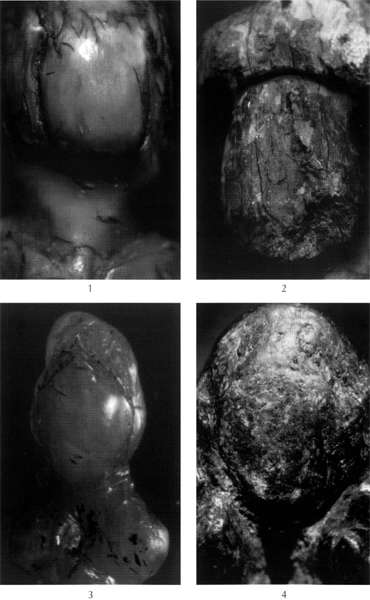
Fig. 15 - Details of several facial Grimaldi figurines:
1 - 'Brown Ivory Figurine' (coll. Bolduc)
2 - the 'Ivory figurine in red ochre' (coll. Bolduc)
3 - 'Two-Headed Woman' (coll. Lavigne)
4 - the 'Flattened figure' (coll. Bolduc)
Photo: R. White
Source: White et Bisson (1998)
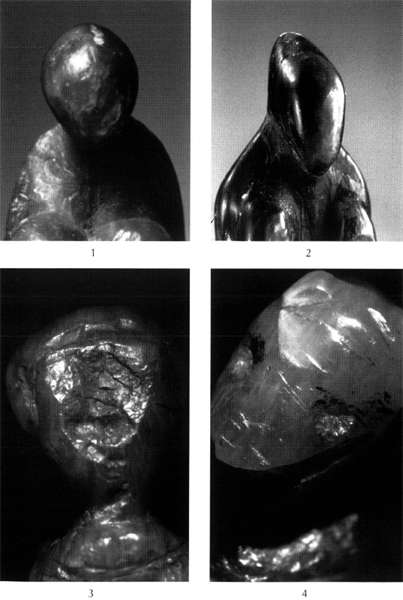
Fig. 16 - Facial details of several Grimaldi figurines:
1 - 'Yellow steatite statuette' (coll. MAN, photo S. Brimberg / National Geographic)
2 - the 'Losange' (coll. MAN, photo S. Brimberg / National Geographic)
3, 4 - the 'Double figure' (coll. Bolduc, photo R White).
Source: White et Bisson (1998)

Fig. 17 - Facial details of 'Woman with the perforated neck' (coll. Peabody Museum, Harvard, photos R. White).
See also fig. 5 and 14.
Source: White et Bisson (1998)

Fig. 18 - Details of incisions:
(left) lower part of the 'Hermaphrodite' showing the area of vertical incisions (coll. MAN).
(right) the hair of the 'Ivory figurine in red ochre' (coll . Bolduc).
See also fig. 5 and 14.
Photo: R. White
Source: White et Bisson (1998)
The 'Polichinelle', the 'Losange', the 'Yellow steatite statuette' and to a lesser extent, the 'Brown ivory figurine' and 'Woman with goitre' share the largest number of characters but are still highly variable. The 'Two-Headed Woman' and 'double figure' form the other group. What distinguishes this collection is a slight similarity regarding the morphology of the body, and more random combinations for secondary characters.
Small changes over time will eventually become large changes, but the great variability of secondary characters in this collection suggests there was a great deal of individual expression, along with the more permanent stylistic conventions that can also be found in many of the other female representations from Upper Paleolithic Europe.
Comments are needed on some of these pieces. The most enigmatic of them all, the 'Hermaphrodite', which, although endowed with breasts, and clearly pregnant, is depicted with a bulge at the crotch marked by vertical incisions and a trough that runs from the top of the bulge to the base of the protruding abdomen (Fig. 18, left). This bulge was first interpreted as an erect phallus and testicles on a female torso, hence its name.
Recently Duhard (1993) argued that these attributes show a birth, the bulge being the head of a baby emerging and the lines indicating the hair. In support of this interpretation, it should be noted that the technique to represent the hair is identical to that used on the 'Ivory figurine in red ochre' (Fig. 18, right).
The allocation of a sex to the 'Flattened figure' (Fig. 3 and 5) is also problematic because it lacks sexual characteristics evident in the majority of the Grimaldi collection. The head resembles that of the "bust" and that of the 'Woman with a perforated neck', both female, but the upper torso lacks breasts shown in relief. The genital area seems to be feminine but it is also less clear than for other detailed examples. It is possible that the flattened incised profile and breasts were the result of the shape of the stone used for the piece. Only three statuettes, which are unequivocally of women, show facial features, and, in each case, these are crudely executed. Of these, the face of 'Bust' (Fig. 2) has the outline clearly marked but the eyes and mouth are indistinct. The two faces of the 'Woman with a perforated neck' (Fig. 17) are very simply executed, and the face of the woman in the 'Double figure' seems to have been erased (Fig. 16, No. 3). The two sculptures that are heads without bodies, without any indication of sex, have clear facial features and are executed with fine details , such as the animal head on the 'Double figure' (Fig. 16, No. 4).
Chronology
The ages of these specimens are difficult to assess, with the exception of those associated with radiocarbon dates recently obtained from Barma Grande. It may be that the 'Brown ivory figurine' probably from the Jardin Abbo, is the oldest of these pieces.
Some deposits from the Final Gravettian were found in the neighbouring Grotte des Enfants (Palma di Cesnola, 1979), and either a Final Gravettian or Initial Epigravettian were found at the Abri Mochi (Laplace, 1977, Palma di Cesnola, Bietti, 1983) , which overlooks the Jardin Abbo. If this figure was found in situ, it could date from 23 000 to 20 000 years, but the surface of the Jardin Abbo was also covered with earth dug out of Barma Grande, and it is possible that this specimen could have come from this later deposit.
Objects from the Grotte du Prince are the most difficult to date because Jullien kept none of the associated flint. The stratigraphic section published later by Villeneuve (Villeneuve et al, 1919) shows that someone, probably Jullien, removed most of the upper level and part of the second characterised by reddish sand. In the 1920s, Henry Ami formed a small collection of waste objects from the prior excavations at Barma Grande. This collection includes debitage from the Upper Paleolithic, and a bone fragment with incised diagonal lines covered with a reddish sediment indicating a probable origin in the lower layer excavated by Jullien.
Similar features were found on parts of the deposits of the early Epigravettian in other Italian sites (Mussi, 1990, 1991, 1993). According to records indicating that an ivory statuette came from the Grotte du Prince, and comparison of the colours of the sediments, suggesting that it could have been from the lower level, we assume that the 'Ivory figurine in red ochre' may date from this first phase of the early Epigravettian, therefore approximately 20 000 years BP. It may be that some of the soft stone sculptures of the Grotte du Prince are the same age, but it is also quite possible that they come from the top layer (date unknown but later) or a cache in a small cavity near the entrance of the cave, as indicated in correspondence with Jullien Piette.
The statuettes of Barma Grande are easier to date because Jullien gave information on the origin of some of them in his correspondence (Pales, 1972) and because we have recently obtained radiocarbon dates on bones of the Jullien excavations. The 'Woman with perforated neck' was found 6 m below the surface in a layer containing hearths. This layer, containing tools characteristic of the early Epigravettian with notched tools, is dated 17 000 ± 180 BP (Gif-sur-Yvette A95072; Bisson et al, 1996). The 'Bust' and 'Flattened figure', which are raw materials and share many similar traits and stylistic techniques, are probably near contemporaries. The 'Yellow steatite statuette' was found between 4.2 and 4.7 m below the surface, and may be associated with Epigravettian évolué (thus about 16 000 years BP). The 'Woman with goitre' was found between 3 and 4.2 m deep in a layer which is probably the final Epigravettian. A radiocarbon date of 14 110 ±150 BP (Gif-sur-Yvette A95074) may be allotted (with caution) to this layer. It may be that this figure is the same age.
This study demonstrated both the extreme variability of these sculptures and their many attributes in common. It is possible that this variability is the result of a long period of time during which they were produced, but many common iconographic elements show that most of them, if not all, are part of the same tradition. In addition, it is highly probable that the period of use of figurines has covered hundreds of years, being safeguarded and accumulated by successive generations of culturally related groups of people.
Given the lack of clear stratigraphy in the Jullien excavations , it remains possible that some special specimens have been deposited in prehistoric pits dug in the previous levels, as is the case for several gravettian statuettes of the Russian plain. If this is the case (and if it was not noted by Jullien), there may be a stratigraphic mixture manifested in the existing collections.
References
- Bisson M., Bolduc P., 1994: Previously undescribed Figurines from the Grimaldi Caves, Current Anthropology, 35 (4), p. 458-468.
- Bolduc P., Cinq-Mars J., Mussi M., 1996: Les figurines des Balzi Rossi (Italie): une collection perdue et retrouvée, Bull. Société Préhistorique de l’Ariège, 51: 15-53.
- Clark P. et al., 2009: "The Last Glacial Maximum", American Association for the Advancement of Science, 7 August 2009: Vol. 325. no. 5941, pp. 710 - 714.
- Cohen C., 2003: La femme des origines. Images de la femme dans la préhistoire occidentale,, Paris, Belin-Herscher, 2003, 191 pages.
- Delporte H., 1993: L’image de la femme dans l’art préhistorique, Éd. Picard (1993)
- Giraudi C., Mussi M., 1999: The Central and Southern Apennine (Italy) during OIS 3 and 2: the colonisation of a changing environment, ERAUL, 90 : 118 - 129
- Mussi, M., 2002: Earliest Italy: an overview of the Italian Pateolithic and Mesolithic New York: Kluwer Academic, 2002.
- White, R., Bisson M., 1998: Imagerie féminine du Paléolithique : l'apport des nouvelles statuettes de Grimaldi, Gallia préhistoire. Tome 40, 1998. pp. 95-132.
- White, R. , 2002: Une nouvelle statuette phallo-féminine paléolithique: 'La venus des Milandes' (commune de Castelnaud-la-Chapelle, Dordogne), Paleo N° 14 Décembre 2002 – Pages 177 à 198
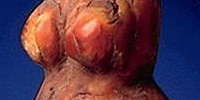 The Brown Ivory Figurine, Figurine en ivoire brun, or Abrachiale, is a nearly complete female figurine made from partially fossilised ivory found at Balzi Rossi. The nearly circular head lacks any indication of facial features or hair and no arms or hands are present. The roughly hemispherical breasts are large and separated from each other by a deep groove. Protruding even more than the breasts is the oval-shaped enlarged abdomen.
The Brown Ivory Figurine, Figurine en ivoire brun, or Abrachiale, is a nearly complete female figurine made from partially fossilised ivory found at Balzi Rossi. The nearly circular head lacks any indication of facial features or hair and no arms or hands are present. The roughly hemispherical breasts are large and separated from each other by a deep groove. Protruding even more than the breasts is the oval-shaped enlarged abdomen.
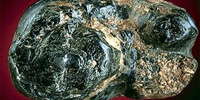 The Bust is a carving in dark-green chlorite and consists only of a head and upper torso. Because of the lack of details surrounding its exact excavation, scholars are unsure as to whether this small – measuring only 29.2 mm – figurine is from Grotte du Prince or Barma Grande. The head is circular and, although the eyes and nose are carved, the mouth exists only in a colour variation in the stone that creates the false impression of a horizontal incision where the mouth should be. The right breast has been broken but the surviving breast is oval and a notch between the breasts makes it appear pendulous with the nipple pointed downward.
The Bust is a carving in dark-green chlorite and consists only of a head and upper torso. Because of the lack of details surrounding its exact excavation, scholars are unsure as to whether this small – measuring only 29.2 mm – figurine is from Grotte du Prince or Barma Grande. The head is circular and, although the eyes and nose are carved, the mouth exists only in a colour variation in the stone that creates the false impression of a horizontal incision where the mouth should be. The right breast has been broken but the surviving breast is oval and a notch between the breasts makes it appear pendulous with the nipple pointed downward.
 In the Double Figurine, the artist has carved two bodies, back to back, symmetrically arched, and joined at the top of the heads, shoulders and lower body. One represents a woman; the other could be an animal. A hollow space separates the two heads, suggesting that the figurine was used as a pendant. With its back to the woman is the other figure, which has elongated, sinuous anatomical features that are difficult to associate with any known genre. Although the torso and lower body offer limited detail for interpretation, the face brings to mind a beast - real or mythical, we do not know. Carved on a fragment of greenish-yellow serpentine and highly polished, the piece is approximately 47 millimetres high.
In the Double Figurine, the artist has carved two bodies, back to back, symmetrically arched, and joined at the top of the heads, shoulders and lower body. One represents a woman; the other could be an animal. A hollow space separates the two heads, suggesting that the figurine was used as a pendant. With its back to the woman is the other figure, which has elongated, sinuous anatomical features that are difficult to associate with any known genre. Although the torso and lower body offer limited detail for interpretation, the face brings to mind a beast - real or mythical, we do not know. Carved on a fragment of greenish-yellow serpentine and highly polished, the piece is approximately 47 millimetres high.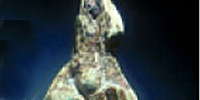 The Woman with Goitre / Goiter from Grimaldi has only one torso and one head, but underneath, she has two pubic triangles and two opposite legs. The figure is made of ivory, and is 45 mm long. The face is ovoid, but there are no facial features shown, and no arms. The breasts are conical with the tips pointed down. There is a goitre at the neck. The belly is prominent, the hips are wide, and the buttocks flattened. The vulva is open, with a gynecological perspective. The legs are broken off below the vulva. The 'Woman with Goitre' was found between 3 and 4.2 m deep in a layer which is probably the final Epigravettian. A radiocarbon date of 14 110 ±150 BP (Gif-sur-Yvette A95074) may be allotted (with caution) to this layer. It may be that this figure is the same age
The Woman with Goitre / Goiter from Grimaldi has only one torso and one head, but underneath, she has two pubic triangles and two opposite legs. The figure is made of ivory, and is 45 mm long. The face is ovoid, but there are no facial features shown, and no arms. The breasts are conical with the tips pointed down. There is a goitre at the neck. The belly is prominent, the hips are wide, and the buttocks flattened. The vulva is open, with a gynecological perspective. The legs are broken off below the vulva. The 'Woman with Goitre' was found between 3 and 4.2 m deep in a layer which is probably the final Epigravettian. A radiocarbon date of 14 110 ±150 BP (Gif-sur-Yvette A95074) may be allotted (with caution) to this layer. It may be that this figure is the same age 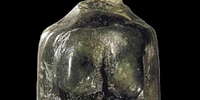 The Hermaphrodite Venus from Balzi Rossi is of translucent green soapstone. The surface is polished and worn, with remains of concretions in the concave parts. The neck, what remains of it, is shown clearly. The torso is very flat, with normal breasts hanging low. The belly is large. Under the stomach are three difficult to interpret features: the central feature is held to be an erect penis, but this is unconvincing. It takes a lot of imagination to distinguish the penis, which remains the essential element of the phallic representation. As for the roughly circular mass that is found below it, it could be a testicular pouch.
The Hermaphrodite Venus from Balzi Rossi is of translucent green soapstone. The surface is polished and worn, with remains of concretions in the concave parts. The neck, what remains of it, is shown clearly. The torso is very flat, with normal breasts hanging low. The belly is large. Under the stomach are three difficult to interpret features: the central feature is held to be an erect penis, but this is unconvincing. It takes a lot of imagination to distinguish the penis, which remains the essential element of the phallic representation. As for the roughly circular mass that is found below it, it could be a testicular pouch.  The Losange Venus, or Venus el Rombo, is made of green steatite. The head is pointed, with a lack of facial features. There is a groove marking the outline of the hair. The breasts are elongated and large. There are no arms. The protruding belly is circular in shape, and the venus has wide hips, and the buttocks are flattened. The vulva is open, and is shown from a gynecological perspective. The legs are tapering, and no knees are indicated. The legs finish or are broken off above the position of the feet.
The Losange Venus, or Venus el Rombo, is made of green steatite. The head is pointed, with a lack of facial features. There is a groove marking the outline of the hair. The breasts are elongated and large. There are no arms. The protruding belly is circular in shape, and the venus has wide hips, and the buttocks are flattened. The vulva is open, and is shown from a gynecological perspective. The legs are tapering, and no knees are indicated. The legs finish or are broken off above the position of the feet.  The Mask, or the Face, is a perforated oval disk in the form of a flattened face or mask. It is made of partially translucent green-yellow to yellow chlorite. Perforations create the eyes and a mouth. The eyes are circular, and small notches give them an animal rather than a human appearance. A series of incised lines radiates from the centre of the face across each cheek. The eyes, nose, and mouth have a vaguely feline appearance, but it may be either a stylised human or an animal. It may be more recent than the statuettes and have come from the rich Early Epigravettian deposits excavated by Jullien in the upper levels of the Barma Grande.
The Mask, or the Face, is a perforated oval disk in the form of a flattened face or mask. It is made of partially translucent green-yellow to yellow chlorite. Perforations create the eyes and a mouth. The eyes are circular, and small notches give them an animal rather than a human appearance. A series of incised lines radiates from the centre of the face across each cheek. The eyes, nose, and mouth have a vaguely feline appearance, but it may be either a stylised human or an animal. It may be more recent than the statuettes and have come from the rich Early Epigravettian deposits excavated by Jullien in the upper levels of the Barma Grande. 
 The Negroid Venus Head, in slightly fibrous green soapstone, has a surface which is polished and worn, especially the face. The base is polished and worn, which suggests that the object was already an isolated head in the Paleolithic. The piece measures 24 mm in height, 24.5 mm front to back and 15 mm maximum width, and is therefore relatively flat and has a protruding chignon of hair. The facial features are strikingly represented: there is a receding forehead with massive eyebrows and deep eye sockets. The cheekbones are strong. The coiffure, largely destroyed, is represented by a net or grid consisting of a series of incisions starting at the forehead, over the bun or chignon and back down onto the neck, cut by transverse incisions, the first of which form a kind of band above the forehead.
The Negroid Venus Head, in slightly fibrous green soapstone, has a surface which is polished and worn, especially the face. The base is polished and worn, which suggests that the object was already an isolated head in the Paleolithic. The piece measures 24 mm in height, 24.5 mm front to back and 15 mm maximum width, and is therefore relatively flat and has a protruding chignon of hair. The facial features are strikingly represented: there is a receding forehead with massive eyebrows and deep eye sockets. The cheekbones are strong. The coiffure, largely destroyed, is represented by a net or grid consisting of a series of incisions starting at the forehead, over the bun or chignon and back down onto the neck, cut by transverse incisions, the first of which form a kind of band above the forehead.
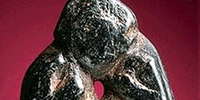

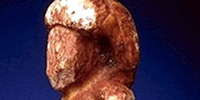 The Red Ochre Venus or Dame Ocrée is a female figurine made from mammoth ivory, and is one of the Grimaldi Venuses. The oval face has no facial features and the head and torso were originally covered with a very thick layer of red ochre. The hair forms a thick coiffure framing the face and tapering to two points that end on the backs of the shoulders, which may be interpreted as being braids. Although the upper arms are clearly carved at the sides of the figurine, there is no trace of forearms or hands.
The Red Ochre Venus or Dame Ocrée is a female figurine made from mammoth ivory, and is one of the Grimaldi Venuses. The oval face has no facial features and the head and torso were originally covered with a very thick layer of red ochre. The hair forms a thick coiffure framing the face and tapering to two points that end on the backs of the shoulders, which may be interpreted as being braids. Although the upper arms are clearly carved at the sides of the figurine, there is no trace of forearms or hands. 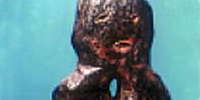 The Woman with the Perforated Neck, also known as the 'Janus' because the face is depicted on both sides of the flattened figurine, is one of the venuses from the Barma Grande in the Balzi Rossi caves. It is 62 mm long, of dark green steatite. The head is flat and circular, with the eyes and mouth carved on the front and back of the head. There are no forearms, and the breasts are oval-shaped. There is a prominent belly, and the buttocks are flattened. A small open vulva has been carved, and the knees and feet are indistinct or absent. It is perforated through the neck.
The Woman with the Perforated Neck, also known as the 'Janus' because the face is depicted on both sides of the flattened figurine, is one of the venuses from the Barma Grande in the Balzi Rossi caves. It is 62 mm long, of dark green steatite. The head is flat and circular, with the eyes and mouth carved on the front and back of the head. There are no forearms, and the breasts are oval-shaped. There is a prominent belly, and the buttocks are flattened. A small open vulva has been carved, and the knees and feet are indistinct or absent. It is perforated through the neck.
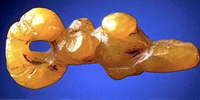 The Woman with Two Heads, or Bicéphale, one of the Grimaldi Venuses, has a body made up of a narrow torso, no arms, projecting breasts and belly, and legs that taper to a point at the knees. The breasts are pointed, extremely large, projected forward, and extend laterally beyond the edge of the torso. Unlike the right breast, the left breast has two grooves circling it and a hole pecked in the tip, presumably representing a nipple. It has a flat back with a faint groove indicating the spine, a narrow waist, and wide hips. The centre of the abdomen is protruding and almost perfectly round and has a small navel in the centre. The large and circular buttocks are marked by a crease at the top and there is a pit carved at the approximate position of the anus. The very large pubic area contains a vulva that is indicated by a vertical groove.
The Woman with Two Heads, or Bicéphale, one of the Grimaldi Venuses, has a body made up of a narrow torso, no arms, projecting breasts and belly, and legs that taper to a point at the knees. The breasts are pointed, extremely large, projected forward, and extend laterally beyond the edge of the torso. Unlike the right breast, the left breast has two grooves circling it and a hole pecked in the tip, presumably representing a nipple. It has a flat back with a faint groove indicating the spine, a narrow waist, and wide hips. The centre of the abdomen is protruding and almost perfectly round and has a small navel in the centre. The large and circular buttocks are marked by a crease at the top and there is a pit carved at the approximate position of the anus. The very large pubic area contains a vulva that is indicated by a vertical groove. The Undescribed Venus of Balzi Rossi is of opaque green soapstone. The oval head and the torso are of normal form and proportions, but the facial features are sketchy, with just sockets for eyes and the outline of a nose. The neck is well formed, the breasts, highly elongated from top to bottom, are separated from each other and the rest of the chest by very deep incisions. The material has changed in nature, and in part has converted to iron hydroxide, while maintaining the fibrous appearance of the original rock. The lower part is broken, we can not know if the statue was in a semi-sitting or standing position, or what was the form of the legs. The surface of the piece is less polished than others in the series, and is also much encrusted with iron concretions.
The Undescribed Venus of Balzi Rossi is of opaque green soapstone. The oval head and the torso are of normal form and proportions, but the facial features are sketchy, with just sockets for eyes and the outline of a nose. The neck is well formed, the breasts, highly elongated from top to bottom, are separated from each other and the rest of the chest by very deep incisions. The material has changed in nature, and in part has converted to iron hydroxide, while maintaining the fibrous appearance of the original rock. The lower part is broken, we can not know if the statue was in a semi-sitting or standing position, or what was the form of the legs. The surface of the piece is less polished than others in the series, and is also much encrusted with iron concretions.
